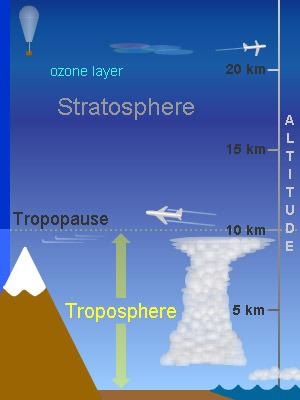A new international study states that climate change is progressively affecting the structure of Earth’s atmosphere.
 Warming temperatures near Earth's surface are slowly pushing up the tropopause, which is the boundary between the two lowest layers of the atmosphere. (Image Credit: Randy Russell, ©UCAR.).
Warming temperatures near Earth's surface are slowly pushing up the tropopause, which is the boundary between the two lowest layers of the atmosphere. (Image Credit: Randy Russell, ©UCAR.).
The study utilizes several years of weather balloon observations and dedicated satellite measurements to measure the extent to which the top of the lowest level of the atmosphere is rising. That region, the tropopause, is pushing up the boundary with the stratosphere by approximately 50-60 m (about 165-195 ft) every 10 years. Findings of the research have been published in Science Advances.
The rising is the result of warming temperatures close to the Earth’s surface that are causing the lower atmosphere to increase.
This is an unambiguous sign of changing atmospheric structure. These results provide independent confirmation, in addition to all the other evidence of climate change, that greenhouse gases are altering our atmosphere.
Bill Randel, Study Co-Author and Scientist, National Center for Atmospheric Research (NCAR)
The international research team was headed by researchers at Nanjing University in China. The study was backed partly by the National Science Foundation, which is NCAR’s sponsor.
Impacts from Greenhouse Gases, Ozone-Destroying Chemicals
The height of the tropopause, an atmospheric region that splits the dense and turbulent troposphere from the overlying and more constant stratosphere, ranges from approximately 5 miles above Earth’s surface at the poles to 10 miles at the equator, based on the season.
The tropopause’s location is of interest to commercial pilots who frequently fly in the lower stratosphere to escape turbulence, and it has a role to play in severe thunderstorms whose overshooting tops occasionally push the tropopause higher and pull down air from the stratosphere.
The progressively increasing height of the tropopause in the last few decades does not considerably impact society or ecosystems, but it demonstrates the extensive impacts of greenhouse gas emissions.
Earlier scientific studies have established that the tropopause is expanding. Besides climate change, this was also because of cooling in the stratosphere related to ozone depletion.
The 1987 Montreal Protocol and international agreements to curb emissions of ozone-destroying chemicals, however, have effectively reversed the loss of ozone and steadied temperatures in the lower stratosphere.
Randel and his co-authors compiled together recently available data to examine how much the tropopause is continuing to expand now that stratospheric temperatures are not having a major impact anymore.
They relied mainly on two sources of information. One was a newly updated archive of interpretations from radiosondes, which have been launched high into the atmosphere for several years on weather balloons to quantify atmospheric properties.
Since the radiosonde data is most thorough over land areas of the Northern Hemisphere between 20 and 80 degrees in latitude, the new study concentrated on the expansion of the tropopause in that region.
The researchers also examined observations from dedicated satellite instruments dating back to 2002 that investigate the atmosphere by determining the degree to which Global Positioning System (GPS) radio signals bend and decelerate as they travel through the atmosphere.
This advanced method, called GPS radio occultation, was established in part by an array of satellites called COSMIC (at present COSMIC-2), whose data is processed and circulated by the University Corporation for Atmospheric Research, which runs NCAR.
The researchers then applied statistical methods to explain the influence of natural events that briefly alter atmospheric temperatures and impact the tropopause, such as volcanic eruptions and the intermittent warming of surface waters in the eastern tropical Pacific Ocean called El Niño. This allowed them to pinpoint the role of human-triggered warming.
Their examination of radiosonde observations revealed that the tropopause has expanded in height at a consistent pace since 1980: about 58-59 m every 10 years, of which 50-53 m per decade is because of human-triggered warming of the lower atmosphere. This development has continued even as the impact from stratospheric temperatures has diminished, showing that warming in the troposphere is having a progressively large impact.
The satellite observations recorded since 2000 confirmed that the height of the tropopause has expanded over the past 20 years.
“The study captures two important ways that humans are changing the atmosphere,” Randel said. “The height of the tropopause is being increasingly affected by emissions of greenhouse gases even as society has successfully stabilized conditions in the stratosphere by restricting ozone-destroying chemicals.”
Journal Reference:
MENG, L., et al. (2021) Continuous rise of the tropopause in the Northern Hemisphere over 1980–2020. Science Advances. doi.org/10.1126/sciadv.abi8065.